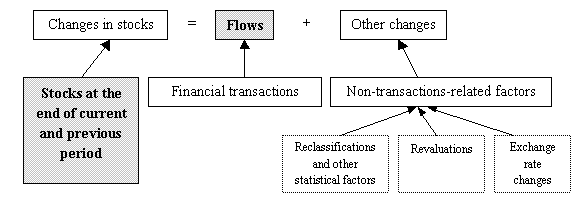Flows in the harmonised balance sheet statistics
The harmonised monetary statistics comprise apart from data on stocks of assets and liabilities of monetary financial institutions (MFI) also data on flows. The stock data show the levels outstanding of the balance sheet items at the end of the reference period (usually a month). The flow data should be covering those changes in the stocks that arise from transactions (i.e. from the acquisition of financial assets or the incurring of financial liabilities).
In the harmonised monetary statistics flows, i.e. financial transactions, are not collected directly from the MFIs. Direct monitoring, recording and reporting would be, due to the great number of such transactions, very demanding on the reporters and in it's consequences ineffective. Flows are rather compiled indirectly focusing on those factors that cannot be considered as financial transactions yet they result in changes in stocks. These factors can commonly be called "non-transaction-related factors" and the changes in stocks they incur as "other changes" in assets and liabilities. By adjusting the difference between end-of-month stocks for these "other changes" the flows for the individual balance-sheet items are derived.
Following "non-transaction-related factors" are taken into account in deriving flow data:
- Reclassifications and other statistical factors - these comprise changes in the assets and liabilities arising from
- changes in the MFI reporting population caused by alterations to sector classifications (inception, termination, change in the main activity of the institution, etc.)
- corporate restructuring (e.g. credit institution transfers parts of its business to a subsidiary outside the MFI sector)
- reclassification of assets and liabilities (e.g. a certain type of product is reclassified to another category by maturity, type, etc.)
- corrections of those reporting errors which, for technical reasons, cannot be removed from the stock data for the complete relevant period
- Revaluations - changes in the levels outstanding due to changes in the book value. They comprise two main categories
- write-offs/write-downs of loans - decrease in the value of loan in case of a write-off or write-down (often with a counterpart in provisions) or in case of loan transfer.
- Revaluation of securities - fluctuation in the levels of securities due to changes in the book value (e.g. due to market price changes)
- Exchange rate changes - changes in the CZK value of foreign currency assets and liabilities stemming from exchange rate fluctuations
